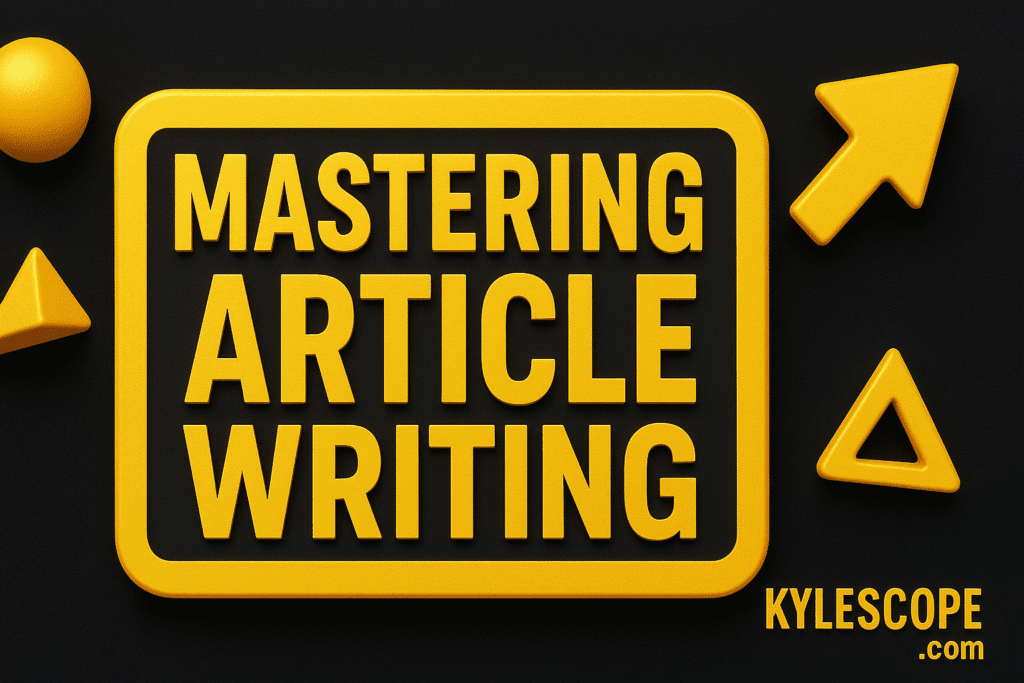
Introduction
Article writing is the backbone of digital publishing. It provides the structure that turns raw ideas into polished, impactful, and scalable content assets. Whether you aim to establish thought leadership, drive organic traffic, or educate your audience, strategic writing ensures that your message reaches the right people most effectively. Businesses, educators, and agencies rely on well-crafted articles to establish authority, nurture trust, and generate measurable results.
In today’s digital-first environment, content is more than just words on a page. It is a system of communication that connects brands with their audiences, researchers with their peers, and educators with their learners. From newsletters that keep communities engaged to landing pages that convert visitors into customers, writing plays a central role in every digital strategy. This guide offers a comprehensive and instructional framework for mastering article writing, with a focus on clarity, structure, and long-term value.
What Is Article Writing?
Definition, Purpose, and Business Value
Article writing refers to the process of creating structured, informative, and purposeful content that is tailored to a specific audience. Unlike casual writing, it follows a clear framework that includes a title, introduction, body, and conclusion. Each section serves a defined purpose, ensuring that the reader can follow the flow of ideas without confusion. The goal is not only to inform but also to persuade, educate, or inspire action.
The business value of article writing lies in its ability to scale communication. A single article can reach thousands of readers, generate backlinks, and establish authority in a niche. For organizations, this means increased visibility, stronger brand positioning, and measurable returns on investment. To understand the fundamentals of structured content, you can explore What Is an Article?, which provides a foundational perspective on the role of articles in digital publishing.
Why Article Writing Matters in Digital Strategy
SEO, Authority, Lead Generation, and Education
In digital strategy, article writing functions as a cornerstone. Search engines prioritize structured, keyword-rich, and authoritative content. By producing well-optimized articles, businesses improve their chances of ranking higher in search results. This visibility translates into organic traffic, which reduces reliance on paid advertising.
Beyond SEO, articles establish authority. When readers encounter consistent, evidence-based writing, they begin to trust the source. This trust leads to stronger brand loyalty and higher conversion rates. Articles also serve as lead generation tools by guiding readers toward newsletters, product pages, or service offerings. Additionally, they educate audiences by breaking down complex topics into digestible insights. For businesses seeking professional support, copywriting services provide tailored strategies that align with broader marketing goals.
Types of Articles
Blog Posts, Instructional Guides, Thought Leadership, and Editorial Pieces
Different types of articles serve different purposes. Blog posts often focus on timely topics, trends, or updates. They are conversational, engaging, and designed to attract readers through search engines and social sharing. Instructional guides, on the other hand, provide step-by-step explanations that help readers solve problems or learn new skills.
Thought leadership articles position the writer as an authority in a field. They combine research, insights, and forward-looking perspectives to influence industry conversations. Editorial pieces, meanwhile, provide commentary or analysis on current issues. Each type requires a unique tone and structure, but all share the goal of delivering value to the reader. To explore how these formats connect with broader marketing strategies, visit copywriting insights.
Article Writing vs. Copywriting
Differences in Tone, Structure, and Intent
Although article writing and copywriting share similarities, they serve distinct purposes. Article writing focuses on informing, educating, and building authority. It uses structured sections, citations, and logical flow to deliver comprehensive insights. The tone is often academic, instructional, or analytical, depending on the audience.
Copywriting, by contrast, emphasizes persuasion. It aims to convert readers into customers by highlighting benefits, addressing pain points, and creating a sense of urgency. The structure is shorter, more direct, and often includes calls to action. Understanding these differences helps businesses decide when to use each approach. For organizations seeking specialized expertise, it is possible to hire a copywriter who can craft persuasive messaging that complements long-form articles.
How to Write an Article That Ranks
Keyword Research, Formatting, Readability, and Internal Linking
Writing an article that ranks requires a strategic approach. Keyword research forms the foundation. By identifying terms that align with audience intent, writers ensure their content appears in relevant search results. Tools like Google Keyword Planner or SEMrush provide valuable insights into search volume and competition.
Formatting also plays a critical role. Clear headings, subheadings, and bullet points improve readability. Short paragraphs and active sentences keep readers engaged. Internal linking enhances site structure by guiding readers to related content, thereby improving dwell time and reducing bounce rates. By combining these elements, writers create content that satisfies both search engines and human readers.
Best Practices for Article Writing
Headline Formulas, Meta Descriptions, Tone, and Citations
Effective headlines capture attention and set expectations. Writers should use formulas that highlight benefits, ask questions, or present numbers. For example, “7 Proven Strategies for Writing Engaging Content” signals both value and structure. Meta descriptions, meanwhile, summarize the article in 150–160 characters, encouraging users to click through from search results.
Tone consistency is equally important. Writers must adapt their voice to the audience, whether academic, professional, or conversational. Citations enhance credibility by grounding arguments in evidence. Using reference managers such as Mendeley or Zotero ensures accuracy and consistency. By following these practices, writers produce content that is both authoritative and engaging.
Article Writing Services: What to Expect
Strategy, Briefs, Optimization, and Deliverables
Professional article writing services offer structured support for businesses seeking to scale their content production. These services begin with strategy, which involves identifying target audiences, relevant keywords, and clear goals. Detailed briefs outline the scope, tone, and structure of each piece, ensuring alignment with brand objectives.
Optimization is another key deliverable. Service providers refine headlines, meta descriptions, and formatting to maximize visibility. They also ensure that articles meet compliance standards and align with SEO best practices. Deliverables often include drafts, revisions, and final polished content ready for publication. For organizations seeking cost-effective solutions, affordable article writing services provide scalable options without compromising quality.
Practical Frameworks for Beginners in Social Media Writing
Applying Article Writing Principles to Social Platforms
Beginners in social media writing can benefit from the same principles that guide article creation. Clarity, structure, and audience focus remain essential. Posts should begin with a hook, provide value in the body, and end with a call to action. Consistency across platforms builds recognition and trust.
Writers should also adapt tone and length to each platform. Twitter requires brevity, LinkedIn favors professional insights, and Instagram thrives on visual storytelling. By applying article writing frameworks to social media, beginners can create posts that engage audiences and support broader digital strategies.
Conclusion and Call to Action
Article writing transforms ideas into structured, scalable, and impactful content assets. It drives SEO, builds authority, and educates audiences across industries. By mastering frameworks, understanding the various types, and applying best practices, writers can create content that resonates with readers and ranks well in search engines.
If you want to elevate your digital strategy with professional support, explore article writing services that deliver strategy, optimization, and measurable results. For additional resources on structured content creation, visit kylescope.com and writing insights. To expand your knowledge further, you can also explore external resources such as the Content Marketing Institute for industry-leading perspectives.
